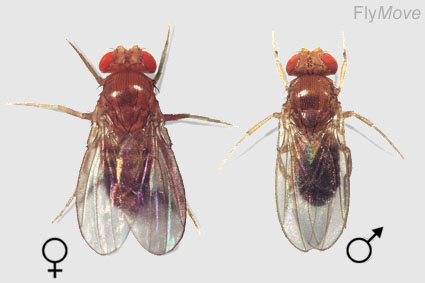
My laboratory uses the fruit fly Drosophila melanogaster as a model for biological processes, and in particular the biology of oxidative stress resistance and ageing. The value of this organism stems largely from its highly developed background of genetic research, and the sophisticated techniques of genome manipulation which are available.
Keeping Drosophila
One of the major attractions of working with Drosophila is the modest culture requirements. We keep flies in plastic vials 8cm x 2cm, containing about 5-10 ml of food, and stoppered with cotton wool. The food is a mixture of dried yeast molasses sugar and cornmeal, thickened with agar (vegetarian jelly), though different labs use slight variations of the same basic recipe.
We keep flies in plastic vials 8cm x 2cm, containing about 5-10 ml of food, and stoppered with cotton wool. The food is a mixture of dried yeast molasses sugar and cornmeal, thickened with agar (vegetarian jelly), though different labs use slight variations of the same basic recipe.
Drosophila breed quickly : at 25oC it take only 10 days from egg to adult!
Of course, to look at the flies under the microscope, we need to stop them moving (but not killing them, since we may need use them to set an experiment up). To do this, we place them in a stream of carbon dioxide, which rapidly puts them to sleep. They also recover very rapidly.
Genetics
Drosophila has been used as a subject of genetic research since early in the 20th century. It is ideally suited, many genetically distinct strains can be maintained in the lab, and large numbers can be examined readily. Mutations affecting a wide variety of characteristics can be identified for study, including mutants altering the fly''s appearance, viability, fertility or behaviour.
Modern molecular genetic techniques in Drosophila are very sophisticated, and we can relatively easily make “designer flies” with particular genetic characteristics.
Drosophila as a model system
Most biological processes are remarkably similar in comparisons between flies and other animals, such as humans. This conservation makes flies particularly useful at investigation fundamental biological processes of great relevance to human health and development, quite apart from the intrinsic interest in investigating biology.
Clicking here take you to a description of a genetic analysis of fly development. It may seem strange at first sight, but the genetic control of basic developmental processes are remarkably similar in flies and man. Some of the key figures in this research, Ed Lewis, Christiane Nusslein-Volhard and Eric Weischaus, were awarded the Nobel Prize for Physiology and Medicine in 1995, for their pioneering work on the genetics of development in Drosophila.
Flies and ageing
In my lab, we are using flies to investigate lifespan and ageing. Our flies live an average of about 50 days in the culture conditions we use. While this may seem trivial, it''s an extremely important factor, as you cannot complete many lifespan experiments with an animal which has a lifespan measured in years. An additional factor is that we can breed large numbers of flies, and the large sample sizes make statistical interpretation easier.
We have been studying the consequences of increasing the fly''s resistance to chemical damage, and evaluating the correlation with lifespan.
Links to online resources
FlyBase – the Drosophila genetics and molecular biology database
The Bloomington Stock Center – The largest Drosophila stock centre
The Szeged stock centre
The Tucson stock centre – Drosophila species
The FlyBase BLAST service
Berkeley Drosophila Genome Project (BDGP)

